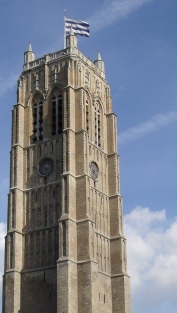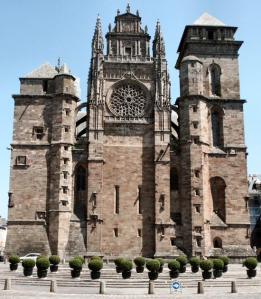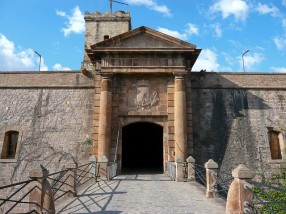
The Belfry in Dunkirk by Harry NL
After the French Revolution, France was changed and changing. Old units of measurement were too linked to the previous regime, they had to be thrown out. Lengths varied region to region and country to country, but that was old France; in 1790, just one year after the French Revolution, they started – on a surprisingly long journey – to find a universal length. The metre.
The first idea was a pendulum which would swing to and fro in a total time of 1 second, the length of the pendulum would become the metre. The length was close to other lengths in use such as the English Yard. Unfortunately a pendulum that performs a full swing in 1 second in Paris would do the same motion in a different time if moved. A pendulum in London moves at a different speed to one in Paris. The idea did not gain traction.
June 17 1771 King Louis XVI charged a commission chosen by the Academy of Sciences to pursue and create the metre. The commission was a group of 12 dedicated scientists and mathematicians, the leader was Jean Charles de Borda. Jean-Charles de Borda was an eminent French Mathematician, physicist and fan of decimalisation. He detested the idea of the second-pendulum because of both its errors and a more personal gripe, the second was a unit of time, and time wasn’t measured in units of ten, it just wasn’t decimal enough. He preferred the system of 10 hours to a day, 100 minutes to an hour and 100 seconds to the minute and so on. Unfortunately for him this decimal time system was being used in exactly 0 countries, so he and the 11 others looked into alternatives.
The commission decided to find an actual length as opposed to something that changed, and so they found a suitably solid, and decimalised solution. The distance from the North Pole to the equator, divided by ten million. The distance would be measured along the line from the north pole and down through Paris. This was the Paris Meridian, once they had decided it, they found it was wonderfully measurable. It was both patriotic and practical, a portion of the quadrant approximately one tenth of the total length could be totally surveyed and the both the start and end point could be measured at sea level.
Using older measurements, the Academy of Sciences made an estimate of that length and produced many platinum bars of an approximate metre. Then they set out to accurately measure it themselves using the most accurate instruments of the day, including the ‘repeating circle’ invented by Jean-Charles de Borda himself. It measured, rather conveniently, quadrants like the one the Paris meridian passed through. It was divided t into unsurprisingly decimal ‘grades’ of 100, each of which was divided into 100 minutes each of which was divided again into 100 seconds.
The task of measuring the full 1000km fell to two Mathematicians and Astronomers, Pierre Méchain and Jean-Baptiste Delambre. In 1792 they departed with the instruments, a specialised coach each and a skilled assistant. The task would take them seven years.

Rodez Cathedral by Jean-Paul Cronimus
The monumental task was split into two, each Mathematician took to their own piece and set about their measurements. Méchain took the south, a 333.0 km stretch, measured from the fortress atop Montjuïc – a hill in Barcelona – up to the towering sandstone walls of the Rodez Cathedral in Southern France. Delambre took the Northern stretch, 742.7km from Rodez Cathedral up to the elegant free-standing Belfry in Dunkirk, a town in the far north of France just 10km from the border with Belgium.
Measurement was arduous and dangerous in equal amounts. In the aftermath of the Revolution the King was imprisoned(only a day after ordering the creation of the universal metre) and new governments came and went; not all of them cared for the endeavour. Delambre at one point had to accurately measure a baseline of 10km using only four accurate metal rods 3.9m long; the whole exercise took him and his assistant six weeks. At other times things were slightly more, invigorating.
Whilst heading north he was detained by the French Militia because his credentials were signed by the king, who was still in jail. At the town of Saint-Denis he was met by an angry mob who thought he was an aristocrat, he only managed to survive by delivering a sudden, impassioned lecture on how the metric process was another piece of the revolution. At Herment he needed to make measurements of a tower, so he hung a white flag from it so as to better observe it, unfortunately white was the colour of the hated Royalist flag. The townspeople were so enraged that he had to sew red and white strips into it to make it look like the French tricolour flag. On the outskirts of Paris he barely escaped the Guillotine.
His counterpart Méchain had a much harder time of it though. Even though he had a much shorter distance to survey it came with two inherent problems, firstly it contained the Pyrenees, a rather noticeable mountain range. Secondly it included several areas of Spain which had never even been surveyed before, the parts Delambre was measuring had been measured twice previously.

- Montjuic Fortress by Andy Mitchell
Furthermore Méchain had only visited three sites when he was first arrested in the town of Essone. The townspeople thought the measuring instruments were peculiar weapons and that he was performing counter-revolutionary activities. He was later released and allowed into Spain. In Spain he received an injury and when he had recovered and taken the measurements he couldn’t go back to France. Why? The two countries had started a war with each other. In Barcelona at the Montjuïc fortress he calculated the Latitude using the stars but he made a 3% error due to light refraction in the atmosphere. By 1774 he realised his error but it was far too late. He was then allowed back into France and learned that during the Reign of Terror all of his possessions had been seized and his family was suffering greatly. He also learned that the Paris Meridian project had been cancelled. He stayed in the French town of Genoa for a year, presumably recovering.
In April 1975 the project was revitalised and resumed, Méchain was ordered to France but refused. He was plagued with the mistake he made in Barcelona even though he had partially rectified it by extending his Meridian to the Balearic Isles. Additionally he knew that many Scientists and Mathematicians had been put to the Guillotine in Paris (his colleague Delambre very nearly joined them) so he spent the next two years avoiding Paris and getting very little done in and around Marseille. He left in 1797 and arrived in Paris in late 1799 he returned to Paris, seven years after his departure. Both Méchain and Delambre received a Hero’s welcome.
Then came the checking of the numbers, calculations were so incredibly complicated due to the need for accuracy and the lack of anything like a calculator for assistance. Another difficulty was converting degrees from the very decimal measures on the instruments to the old 360 degrees which every calculation was written for. At the end the metre was found and from the many provisional platinum bars the closest was chosen and made into the metre. This ‘prototype’ metre was placed in the National Archives on the 22nd April 1799 as a permanent record. The bar was from then known as the metré des Archives. The whole metric system based on the metre was introduced later that year.
Initially the new system was met with a surprising opposition from large portions of the French populace, they didn’t want to have to learn new units. Two years later the metre and the other measures based upon it became the only form of measurement in France. Even though this one was perhaps not as violent, it was another revolution altogether.
One last area of interest remains in the life of Pierre Méchain. Racked with guilt at his error he refused to publish his results publicly. In 1803 he got permission from Napoleon to return to Barcelona and retake his measurements and remove his mistake from his guilt-racked conscience. He took some of the measurements but before his work was completed he contracted Yellow Fever. He died in 1804, unsatisfied. So it was left to Delambre to finish the work. He visited Barcelona and took the measurements before returning to Paris and amending the metre. After this the project was finally complete after more than 20 years.
Afterwards came changes, but only adjustments. As the metre bar became more widely used in the 19th Century its flaws emerged, there was no way of ensuring each bar was exactly one metre and no way of removing all the wear and tear which made the bars shrink over time. So it was changed, in 1875 the Metre Convention was signed in Paris. The result was an international organisation with the aim of conserving new ‘prototypes’ and to compare them with other bars to check standards.
The new prototype was built with the most cutting edge technology of that era. The bar was over 1 metre long but had lines on it separated by a metre so that when a bar were to wear down it can still be used to accurately represent a metre. Initial attempts in France where not accurate enough so a London firm was used and it successfully manufactured 3- bars. They were all measured to the nearest 5 billionth of a metre. The bars were made of 90% Platinum and 10% Iridium, forming a bar much harder than the platinum original, even its cross-section was a special shape designed to reduce torsion. That there was the end of the line, the only later adjustment was that the bars had to be measured at the temperature of ice for consistency in all climates.
These days the bars are still around but are not the definition of a metre any more. So that the metre could be exactly accurate it was redefined in terms of universal constants after developments in electronics and the invention of the Laser. Allowing the accurate calibration of a metre across the whole Universe. A metre is now:
“…the length of the path travelled by light in a vacuum during 1⁄299 792 458 of a second.”
The metre formed the base for all of the standard units of length and revolutionised science with a new found unity and equality. The metre was described as a measure “for all people, for all time.” It all started with a pair of Mathematicians running across, and being regularly arrested, in France and Spain for seven years. The task was monumental to the modern world and is oft taken for granted by many.
The task and its effects are perhaps, beyond measure.
Article idea suggested by Jack Evans – many thanks.
Further Reading